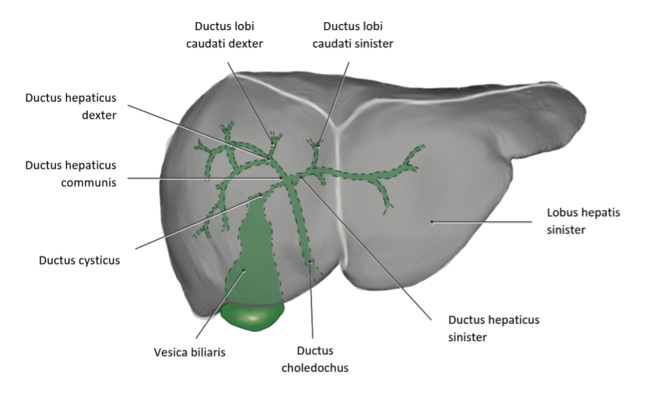Gallbladder (Vesica billiaris)
Inhaltsverzeichnis
Projection of the gall bladder and extrahepatic bile ducts onto the trunk
The mouth of the Ductus pancreaticus lies at the level of the 2nd lumbar vertebral body. In the right medioclavicular line, however, the gall bladder is visible at the lower edge of the 9th rib. Below the costal arch is the gall bladder at the level of the 1st or 2nd lumbar vertebra.
Projection of intra- and extrahepatic bile ducts onto the surface of the liver
Intrahepatic bile ducts
All bile ducts up to the hepatic orifice (porta hepatis) are called intrahepatic bile ducts. Small bile ducts (Canaliculi biliferi) are the bile ducts between the liver cells (hepatocytes). The bile ducts move from the center of a liver lobule to the lobule surface. Here they pass into the short herring ducts (Ductuli biliferi). These again flow into the bile ducts inside the liver lobules (Ductus biliferi interlobulares). They merge into ever larger units and eventually lead to the large intrahepatic liver ducts, the Ductus hepaticus dexter and the Ductus hepaticus sinister.
Extrahepatic bile ducts
Extrahepatic bile ducts are those that are located outside the liver. The ductus hepaticus, which in most cases is outside the liver, proceeds from the left and right hepatic duct near the porta hepatis. The ductus cysticus is one way to store bile in the gall bladder. The ductus choledochus runs in the ligamentum hepatoduodenale to the duodenum. The last section of the ductus choledochus merges with the ductus pancreaticus of the pancreas to form the ampulla hepatopancreatica. This in turn flows through the papilla duodeni major into the duodenum.
Position of the gall bladder in relation to the neighbouring organs
In the "WebViewer" stomach, small intestine, colon transversum, peritoneum in the area of lig. hepatoduodenal are removed and the liver is shown transparent. The gall bladder is firmly connected by the connective tissue of the Fossa vesicae biliaris. The ductus choledochus runs behind the duodenum towards the pancreatic head and through it (not visible in "WebViewer"). Depending on this, the Ductus choledochus either flows together or separately with the Ductus pancreaticus on the Papilla duodeni major in the Pars descendens duodeni.
Structure of the gall bladder and extrahepatic bile ducts
Die Gallenblase besteht aus einem Hals (Collum), einem Körper (Corpus) und einem Blasengrund (Fundus). Das Corpus vesicae biliaris geht über den Gallenblasentrichter in den Hals. Der Ducuts cysticus (Gallenblasengang) knüpft am Hals an, welcher im Ductus hepaticus communis mündet. Als Ductus choledochus wird der große Gallengang bezeichnet. Dort mündet der Ductus pancreaticus, beide Gänge leiten ihre Verdauungssekrete über die Papila duodeni major in das Duodenum.
Es gibt weitere Varianten der Mündungen von Ductus choledochus und Ductus pancreaticus. Seltener sind Gallenblase und Ductus cysticus doppelt angelegt. Eine weitere Variante ist eine fast vollständig septierte gemeinsame Ampulle. Möglich sind ebenfalls eine Mündung ohne echte Ampulle und eine Doppelmündung beider Gänge.
(Grafik folgt)
weiterführende Links

